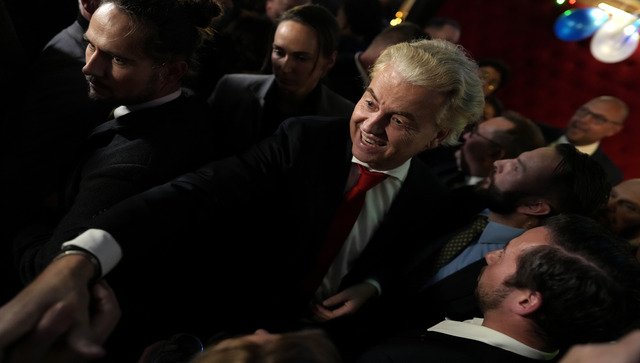Europe is witnessing a far-right shift. The victory of populist Geert Wilders in the Dutch elections seems to have further confirmed this. Known for his anti-Islam and anti-immigration stance, Wilders will likely be the next prime minister of the Netherlands replacing centrist Mark Rutte. Wilders’ Freedom Party (PVV) has won 37 seats out of 150 in the lower house of Parliament. As Wilders holds talks to form a new ruling coalition, he is positioned to become the first hard-right PM of the Netherlands.
Wilders
’ success has once again put the spotlight on the rise of hard-right in Europe. Let’s take a look at how the influence of the far-right has spread across the continent. Italy The party of Italian prime minister Giorgia Meloni has neo-fascist roots. Italy, the European Union’s (EU) third-largest economy, favoured Meloni’s Brothers of Italy with nearly 26 per cent of the vote in last year’s September elections, paving the way for a rightwing coalition with Silvio Berlusconi’s Forza Italia and Matteo Salvini’s League, as per The Guardian report. With this, western Europe got its first far-right postwar PM in Meloni, the report added. [caption id=“attachment_13422012” align=“alignnone” width=“640”] Italy PM Giorgia Meloni’s party has neo-fascist roots. Reuters File Photo[/caption] Since coming to power, she has focused on curbing migration, attaining economic sovereignty, endorsing and promoting traditional Christian values and “Western civilisation”, according to Al Jazeera. France In France, self-described centrist Emmanuel Macron is in power. However, the far-right has seen increasing support in the country. Macron’s political rival on the far-right, Marine Le Pen, secured a record 41.46 per cent in the presidential elections last year. Her far-right National Rally (RN) won 89 of the 577 seats in Parliament, making it the largest single Opposition party, as per the British daily. A poll in April this year found that Le Pen would trounce Macron if presidential elections were held at the time. Germany Germany has reported a surge in support for the hard-right Alternative für Deutschland (AfD). As per an NPR report in October, the AfD party, accused of far-right extremism, polled higher than each of the three parties in the coalition government in Germany. The party has already witnessed support at the local level. Opinion polls say that at the national level, electors prefer “xenophobic, anti-Islam” AfD than Chancellor Olaf Scholz’s Social Democrats, noted The Guardian. Spain bucks the trend Spain’s far-right Vox Party was expected to be the kingmaker in the snap elections held in July, with the centre-right People’s party (PP) coming to power. However, things did not go as predicted. Spanish prime minister Pedro Sanchez won Parliament’s support to return to power after finalising a controversial deal with Catalan separatists. In June, the Vox Party had performed beyond expectations in the regional elections. But for now, Spain seems to have bucked the European shift towards the far-right. Other European countries
Switzerland
’s far-right and euroskeptic Swiss People’s Party (SVP) dominated the national elections by securing 62 of the 200 seats in the Parliament’s lower chamber, as per the results in October. In Finland, the far-right nationalists The Finns are part of the four-party coalition government, which is the country’s most rightwing in history. Finland was previously ruled by a left-leaning coalition government under Social Democrat Sanna Marin. [caption id=“attachment_13422022” align=“alignnone” width=“640”]
Italy PM Giorgia Meloni’s party has neo-fascist roots. Reuters File Photo[/caption] Since coming to power, she has focused on curbing migration, attaining economic sovereignty, endorsing and promoting traditional Christian values and “Western civilisation”, according to Al Jazeera. France In France, self-described centrist Emmanuel Macron is in power. However, the far-right has seen increasing support in the country. Macron’s political rival on the far-right, Marine Le Pen, secured a record 41.46 per cent in the presidential elections last year. Her far-right National Rally (RN) won 89 of the 577 seats in Parliament, making it the largest single Opposition party, as per the British daily. A poll in April this year found that Le Pen would trounce Macron if presidential elections were held at the time. Germany Germany has reported a surge in support for the hard-right Alternative für Deutschland (AfD). As per an NPR report in October, the AfD party, accused of far-right extremism, polled higher than each of the three parties in the coalition government in Germany. The party has already witnessed support at the local level. Opinion polls say that at the national level, electors prefer “xenophobic, anti-Islam” AfD than Chancellor Olaf Scholz’s Social Democrats, noted The Guardian. Spain bucks the trend Spain’s far-right Vox Party was expected to be the kingmaker in the snap elections held in July, with the centre-right People’s party (PP) coming to power. However, things did not go as predicted. Spanish prime minister Pedro Sanchez won Parliament’s support to return to power after finalising a controversial deal with Catalan separatists. In June, the Vox Party had performed beyond expectations in the regional elections. But for now, Spain seems to have bucked the European shift towards the far-right. Other European countries
Switzerland
’s far-right and euroskeptic Swiss People’s Party (SVP) dominated the national elections by securing 62 of the 200 seats in the Parliament’s lower chamber, as per the results in October. In Finland, the far-right nationalists The Finns are part of the four-party coalition government, which is the country’s most rightwing in history. Finland was previously ruled by a left-leaning coalition government under Social Democrat Sanna Marin. [caption id=“attachment_13422022” align=“alignnone” width=“640”] Finland’s then prime minister Sanna Marin, National Coalition leader Petteri Orpo, and Finns Party leader Riikka Purra attend a Finnish parliamentary elections media reception at the Finnish Parliament in Helsinki, Finland, on 2 April 2023. Reuters File Photo[/caption] Sweden’s conservative leader has the backing of the anti-immigration, far-right Sweden Democrats – the second-largest party in Parliament. In June, Greece became the only European nation with three far-right parties in its legislature. Hungary is already ruled by far-right leader Viktor Orbán. In Austria, which goes to polls next year, right-wing populist Freedom Party (FPÖ) has become more popular than in 2017 when it was in power, as per Euronews. Why is Europe embracing the far-right? The surge of the far-right in Europe has been shocking. Not only the hardliners are directly in power in many countries, but in other nations, they are also influencing policy decisions. “There has been a convergence of the center right and the far right over the past decade or so,” Hans Kundnani, a European political analyst at the Chatham House, told Politico. He said this shift “may have profound consequences for the EU.” The EU will elect a new European Parliament next year and this rightward gravitation could result in a conservative Brussels for the coming years, reported Politico. The EU matters as its European Council, which brings together the bloc’s 27 leaders, defines the Union’s political priorities and policy initiatives. According to Al Jazeera, the intensifying cost of living crisis, opposition to multiculturalism and “woke” culture wars could be the reasons behind the entry of the far right into mainstream politics. “For long, opposition to immigration, Islam and the EU were what united Europe’s far-right parties. New causes have now also emerged: the culture wars, minority rights, the climate crisis and the unfair sacrifices that governments insist will be needed to combat it,” a piece in The Guardian explained. “Their appeal has been further enhanced by the cost of living crisis flowing from pandemic recovery and Russia’s war on Ukraine; by rapid and confusing social and digital change and, everywhere, by mounting mistrust of the mainstream,” the article added. Will this allure of the far-right continue or eventually wane in Europe? Only time can tell. With inputs from agencies
Finland’s then prime minister Sanna Marin, National Coalition leader Petteri Orpo, and Finns Party leader Riikka Purra attend a Finnish parliamentary elections media reception at the Finnish Parliament in Helsinki, Finland, on 2 April 2023. Reuters File Photo[/caption] Sweden’s conservative leader has the backing of the anti-immigration, far-right Sweden Democrats – the second-largest party in Parliament. In June, Greece became the only European nation with three far-right parties in its legislature. Hungary is already ruled by far-right leader Viktor Orbán. In Austria, which goes to polls next year, right-wing populist Freedom Party (FPÖ) has become more popular than in 2017 when it was in power, as per Euronews. Why is Europe embracing the far-right? The surge of the far-right in Europe has been shocking. Not only the hardliners are directly in power in many countries, but in other nations, they are also influencing policy decisions. “There has been a convergence of the center right and the far right over the past decade or so,” Hans Kundnani, a European political analyst at the Chatham House, told Politico. He said this shift “may have profound consequences for the EU.” The EU will elect a new European Parliament next year and this rightward gravitation could result in a conservative Brussels for the coming years, reported Politico. The EU matters as its European Council, which brings together the bloc’s 27 leaders, defines the Union’s political priorities and policy initiatives. According to Al Jazeera, the intensifying cost of living crisis, opposition to multiculturalism and “woke” culture wars could be the reasons behind the entry of the far right into mainstream politics. “For long, opposition to immigration, Islam and the EU were what united Europe’s far-right parties. New causes have now also emerged: the culture wars, minority rights, the climate crisis and the unfair sacrifices that governments insist will be needed to combat it,” a piece in The Guardian explained. “Their appeal has been further enhanced by the cost of living crisis flowing from pandemic recovery and Russia’s war on Ukraine; by rapid and confusing social and digital change and, everywhere, by mounting mistrust of the mainstream,” the article added. Will this allure of the far-right continue or eventually wane in Europe? Only time can tell. With inputs from agencies
Geert Wilders wins big in Dutch polls: How far-right is rising in Europe
FP Explainers
• November 23, 2023, 21:02:26 IST
Populist leader Geert Wilders is expected to be the next Dutch PM. His triumph has once again put the spotlight on the surge of the far-right in Europe. From Italy to Sweden, here’s how the rightwing appeal has grown across the continent
Advertisement
)
End of Article